|
Microsoft Developing SQL Databases (70-762) Exam Page5(Dumps)
Question No:-21
|
Note: This question is part of a series of questions that use the same scenario. For your convenience, the scenario is repeated in each question. Each question presents a different goal and answer choices, but the text of the scenario is exactly the same in each question in this series.
You have a database named DB1 that contains the following tables: Customer, CustomerToAccountBridge, and CustomerDetails. The three tables are part of the Sales schema. The database also contains a schema named Website. You create the Customer table by running the following Transact-SQL statement:
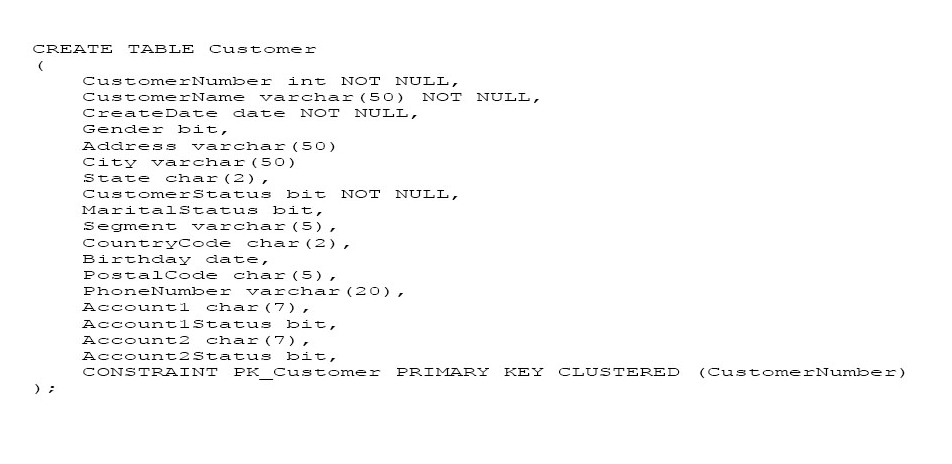
The value of the CustomerStatus column is equal to one for active customers. The value of the Account1Status and Account2Status columns are equal to one for active accounts. The following table displays selected columns and rows from the Customer table.

You plan to create a view named Website.Customer and a view named Sales.FemaleCustomers.
Website.Customer must meet the following requirements:
1. Allow users access to the CustomerName and CustomerNumber columns for active customers.
2. Allow changes to the columns that the view references. Modified data must be visible through the view.
3. Prevent the view from being published as part of Microsoft SQL Server replication.
Sales.Female.Customers must meet the following requirements:
1. Allow users access to the CustomerName, Address, City, State and PostalCode columns.
2. Prevent changes to the columns that the view references.
3. Only allow updates through the views that adhere to the view filter.
You have the following stored procedures: spDeleteCustAcctRelationship and spUpdateCustomerSummary. The spUpdateCustomerSummary stored procedure was created by running the following Transacr-SQL statement:

You run the spUpdateCustomerSummary stored procedure to make changes to customer account summaries. Other stored procedures call the spDeleteCustAcctRelationship to delete records from the CustomerToAccountBridge table.
You must update the design of the Customer table to meet the following requirements.
1. You must be able to store up to 50 accounts for each customer.
2. Users must be able to retrieve customer information by supplying an account number.
3. Users must be able to retrieve an account number by supplying customer information.
You need to implement the design changes while minimizing data redundancy.
What should you do?
A. Split the table into three separate tables. Include the AccountNumber and CustomerID columns in the first table. Include the CustomerName and Gender columns in the second table. Include the AccountStatus column in the third table.
B. Split the table into two separate tables. Include AccountNumber, CustomerID, CustomerName and Gender columns in the first table. Include the AccountNumber and AccountStatus columns in the second table.
C. Split the table into two separate tables, Include the CustomerID and AccountNumber columns in the first table. Include the AccountNumber, AccountStatus, CustomerName and Gender columns in the second table.
D. Split the table into two separate tables, Include the CustomerID, CustomerName and Gender columns in the first table. Include AccountNumber, AccountStatus and CustomerID columns in the second table.
|
Answer:-D. Split the table into two separate tables, Include the CustomerID, CustomerName and Gender columns in the first table. Include AccountNumber, AccountStatus and CustomerID columns in the second table.
Hint:-
Two tables is enough.CustomerID must be in both tables.
|
|
Question No:-22
|
DRAG DROP -
Note: This question is part of a series of questions that use the same scenario. For your convenience, the scenario is repeated in each question. Each question presents a different goal and answer choices, but the text of the scenario is exactly the same in each question in this series.
You have a database named DB1 that contains the following tables: Customer, CustomerToAccountBridge, and CustomerDetails. The three tables are part of the Sales schema. The database also contains a schema named Website. You create the Customer table by running the following Transact-SQL statement:
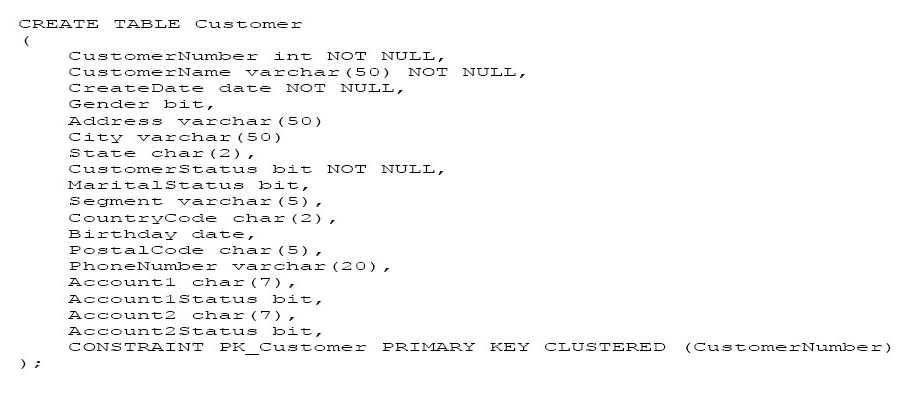
The value of the CustomerStatus column is equal to one for active customers. The value of the Account1Status and Account2Status columns are equal to one for active accounts. The following table displays selected columns and rows from the Customer table.

You plan to create a view named Website.Customer and a view named Sales.FemaleCustomers.
Website.Customer must meet the following requirements:
1. Allow users access to the CustomerName and CustomerNumber columns for active customers.
2. Allow changes to the columns that the view references. Modified data must be visible through the view.
3. Prevent the view from being published as part of Microsoft SQL Server replication.
Sales.Female.Customers must meet the following requirements:
1. Allow users access to the CustomerName, Address, City, State and PostalCode columns.
2. Prevent changes to the columns that the view references.
3. Only allow updates through the views that adhere to the view filter.
You have the following stored procedures: spDeleteCustAcctRelationship and spUpdateCustomerSummary. The spUpdateCustomerSummary stored procedure was created by running the following Transacr-SQL statement:

The following table displays a selected columns and rows from the Customer table. Thr value of the CustomerStatus column is equal to one for active customers.
The value of the Account1Status and Account2Status columns are equal to one for active accounts.
You run the spUpdateCustomerSummary stored procedure to make changes to customer account summaries. Other stored procedures call the spDeleteCustAcctRelationship to delete records from the CustomerToAccountBridge table.
Users report that the following SELECT statement statement takes a long time to complete:

You need to create an index that meets the following requirements:
1. Improve the performance of the SELECT statement.
2. requires minimum index key size.
3. Only contains active customers.
4. Makes no change to the existing primary key.
5. Contains all of the columns required by the SELECT statement.
Which three Transact_SQL segments should you use to develop the solution? To answer, move the appropriate code blocks from the list of code blocks to the answer area and arrange them in the correct order.
Select and Place:
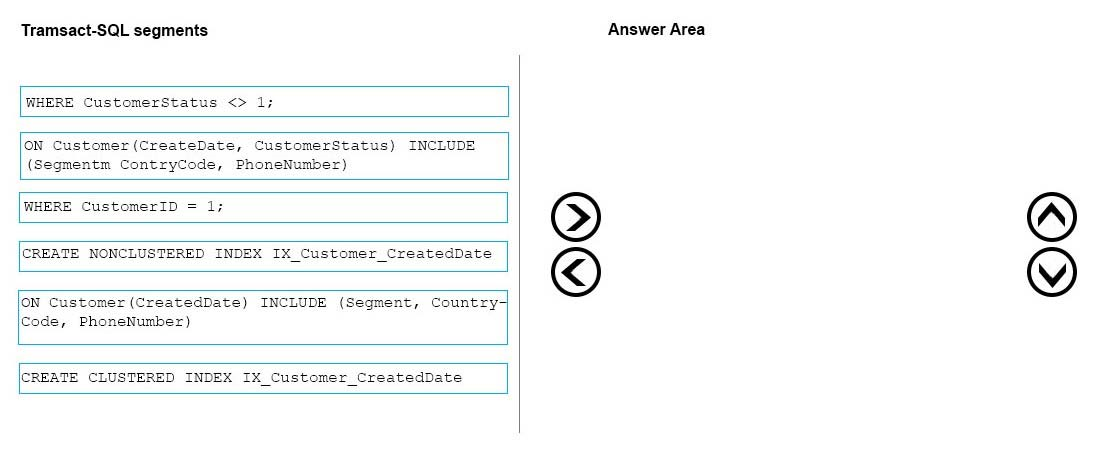
|
Question No:-23
|
DRAG DROP -
Note: This question is part of a series of questions that use the same scenario. For your convenience, the scenario is repeated in each question. Each question presents a different goal and answer choices, but the text of the scenario is exactly the same in each question in this series.
You have a database named DB1 that contains the following tables: Customer, CustomerToAccountBridge, and CustomerDetails. The three tables are part of the Sales schema. The database also contains a schema named Website. You create the Customer table by running the following Transact-SQL statement:
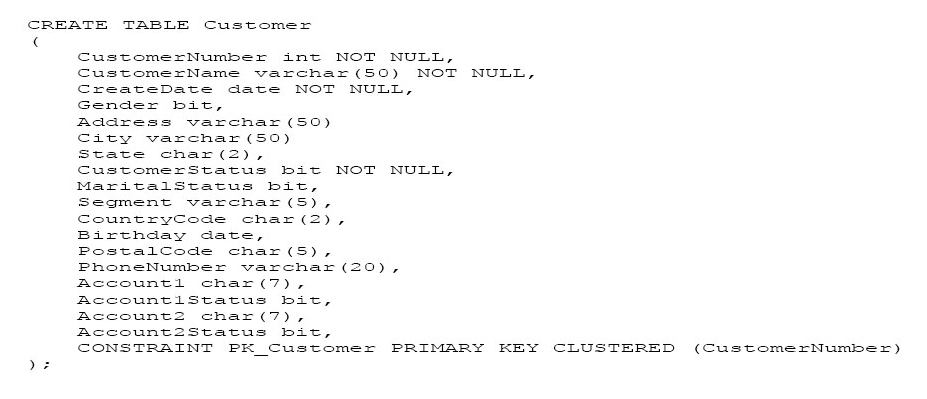
The value of the CustomerStatus column is equal to one for active customers. The value of the Account1Status and Account2Status columns are equal to one for active accounts. The following table displays selected columns and rows from the Customer table.

You plan to create a view named Website.Customer and a view named Sales.FemaleCustomers.
Website.Customer must meet the following requirements:
1. Allow users access to the CustomerName and CustomerNumber columns for active customers.
2. Allow changes to the columns that the view references. Modified data must be visible through the view.
3. Prevent the view from being published as part of Microsoft SQL Server replication.
Sales.Female.Customers must meet the following requirements:
1. Allow users access to the CustomerName, Address, City, State and PostalCode columns.
2. Prevent changes to the columns that the view references.
3. Only allow updates through the views that adhere to the view filter.
You have the following stored procedures: spDeleteCustAcctRelationship and spUpdateCustomerSummary. The spUpdateCustomerSummary stored procedure was created by running the following Transacr-SQL statement:

You run the spUpdateCustomerSummary stored procedure to make changes to customer account summaries. Other stored procedures call the spDeleteCustAcctRelationship to delete records from the CustomerToAccountBridge table.
When a procedure calls spDeleteCustAcctRelationship, if the calling stored procedures has already started an active transaction, all the detections made by the spDeleteCustAccRelationship stored procedure must be committed by the caller; otherwise changes must be committed within the spDeleteCustAcctRelationship stored procedure.
If any error occurs during the delete operation, only the deletes made by the soDeleteCustACCTRelationships stored procedure must be rolled back and the status must be updated.
You need to complete the stored procedure to ensure all the requirements are met.
How should you complete the procedure? To answer, drag the Transact-SQL segments to the correct location. Each transact-SQL segment may be used once, more than once or not at all. You may need to drag the split bar between panes or scroll to view content.
NOTE: Each correct selection is worth one point.
Select and Place:
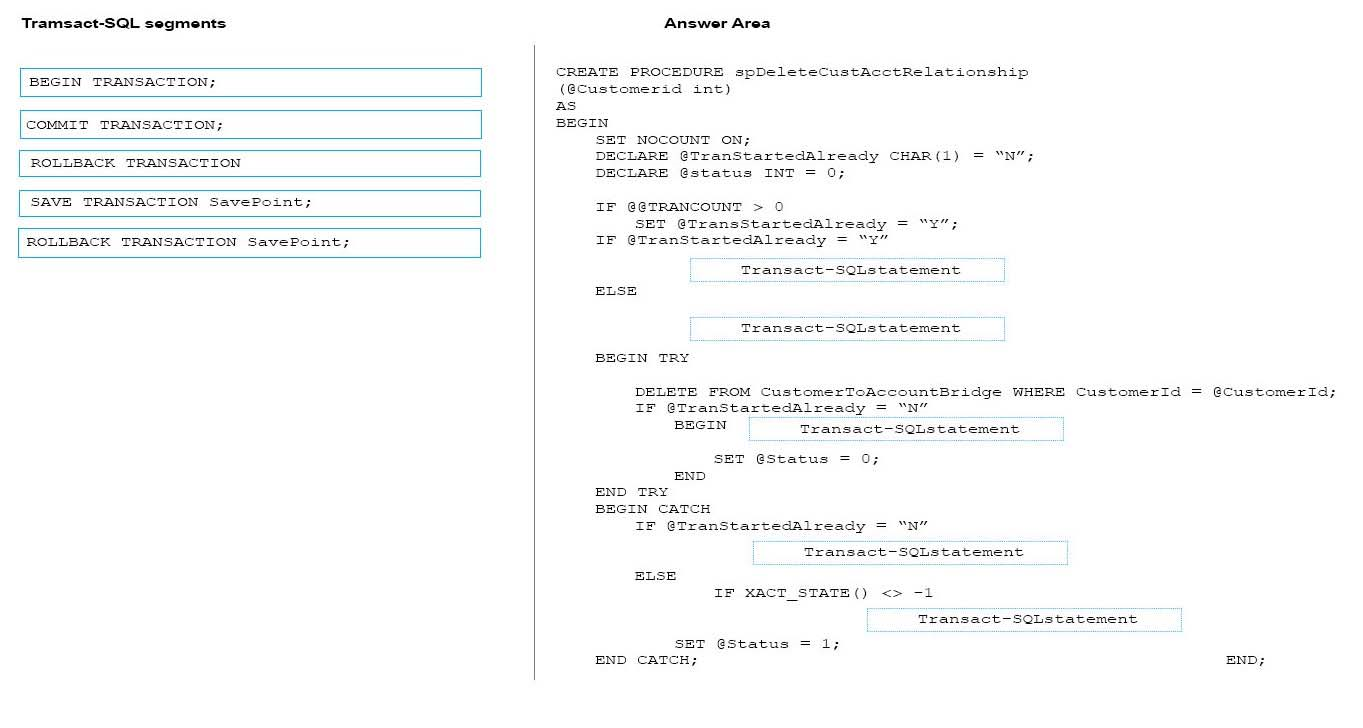
Answer:-
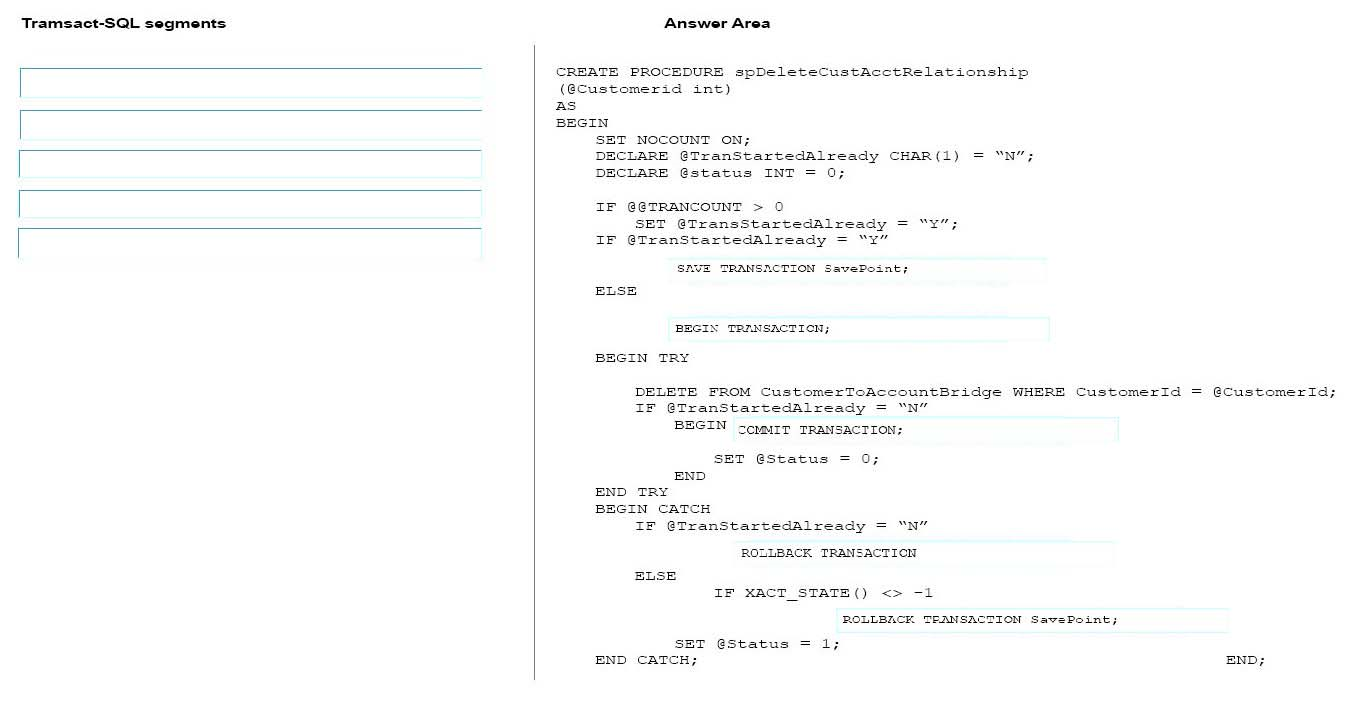 Note:-
Note:-
Savepoints offer a mechanism to roll back portions of transactions. You create a savepoint using the SAVE TRANSACTION savepoint_name statement. Later, you execute a ROLLBACK TRANSACTION savepoint_name statement to roll back to the savepoint instead of rolling back to the start of the transaction.
Reference:-https://technet.microsoft.com/en-us/library/ms178157(v=sql.105).aspx
|
|
Question No:-24
|
DRAG DROP -
Note: This question is part of a series of questions that use the same scenario. For your convenience, the scenario is repeated in each question. Each question presents a different goal and answer choices, but the text of the scenario is exactly the same in each question in this series.
You have a database named DB1 that contains the following tables: Customer, CustomerToAccountBridge, and CustomerDetails. The three tables are part of the Sales schema. The database also contains a schema named Website. You create the Customer table by running the following Transact-SQL statement:
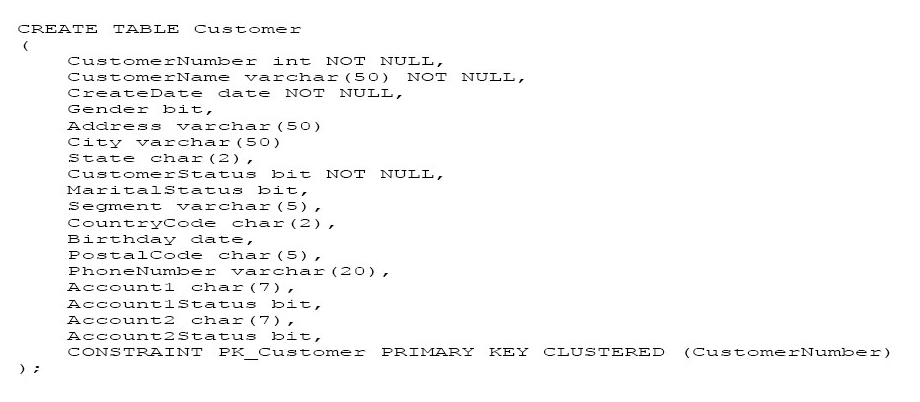
The value of the CustomerStatus column is equal to one for active customers. The value of the Account1Status and Account2Status columns are equal to one for active accounts. The following table displays selected columns and rows from the Customer table.

You plan to create a view named Website.Customer and a view named Sales.FemaleCustomers.
Website.Customer must meet the following requirements:
1. Allow users access to the CustomerName and CustomerNumber columns for active customers.
2. Allow changes to the columns that the view references. Modified data must be visible through the view.
3. Prevent the view from being published as part of Microsoft SQL Server replication.
Sales.Female.Customers must meet the following requirements:
1. Allow users access to the CustomerName, Address, City, State and PostalCode columns.
2. Prevent changes to the columns that the view references.
3. Only allow updates through the views that adhere to the view filter.
You have the following stored procedures: spDeleteCustAcctRelationship and spUpdateCustomerSummary. The spUpdateCustomerSummary stored procedure was created by running the following Transacr-SQL statement:

You run the spUpdateCustomerSummary stored procedure to make changes to customer account summaries. Other stored procedures call the spDeleteCustAcctRelationship to delete records from the CustomerToAccountBridge table.
You need to create Website Customer.
How should you complete the view definition? To answer, drag the appropriate Transact-SQL segments to the correct locations, Each Transact-SQL segment may be used once, more than once or not at all. You may need to drag the split bar between panes or scroll to view content.
NOTE: Each correct selection is worth one point.
Select and Place:

Answer:-
Box 1: WITH ENCRYPTION -
Using WITH ENCRYPTION prevents the view from being published as part of SQL Server replication.
Box 2: WITH CHECK OPTION -
CHECK OPTION forces all data modification statements executed against the view to follow the criteria set within select_statement. When a row is modified through a view, the WITH CHECK OPTION makes sure the data remains visible through the view after the modification is committed.
Note: Website.Customer must meet the following requirements:
1. Allow users access to the CustomerName and CustomerNumber columns for active customers.
2. Allow changes to the columns that the view references. Modified data must be visible through the view.
3. Prevent the view from being published as part of Microsoft SQL Server replication.
Incorrect Asnwers:
SCHEMABINDING binds the view to the schema of the underlying table or tables. When SCHEMABINDING is specified, the base table or tables cannot be modified in a way that would affect the view definition.
VIEW_METADATA specifies that theinstance of SQL Server will return to the DB-Library, ODBC, and OLE DB APIs the metadata information about the view, instead of the base table or tables, when browse-mode metadata is being requested for a query that references the view.
Reference:-https://msdn.microsoft.com/en-us/library/ms187956.aspx
|
|
Question No:-25
|
DRAG DROP -
Note: This question is part of a series of questions that use the same scenario. For your convenience, the scenario is repeated in each question. Each question presents a different goal and answer choices, but the text of the scenario is exactly the same in each question in this series.
You have a database named DB1 that contains the following tables: Customer, CustomerToAccountBridge, and CustomerDetails. The three tables are part of the Sales schema. The database also contains a schema named Website. You create the Customer table by running the following Transact-SQL statement:
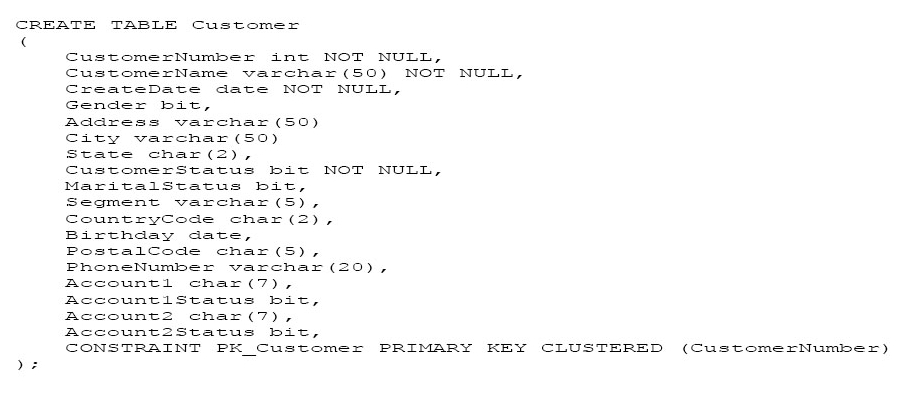
The value of the CustomerStatus column is equal to one for active customers. The value of the Account1Status and Account2Status columns are equal to one for active accounts. The following table displays selected columns and rows from the Customer table.

You plan to create a view named Website.Customer and a view named Sales.FemaleCustomers.
Website.Customer must meet the following requirements:
1. Allow users access to the CustomerName and CustomerNumber columns for active customers.
2. Allow changes to the columns that the view references. Modified data must be visible through the view.
3. Prevent the view from being published as part of Microsoft SQL Server replication.
Sales.Female.Customers must meet the following requirements:
1. Allow users access to the CustomerName, Address, City, State and PostalCode columns.
2. Prevent changes to the columns that the view references.
3. Only allow updates through the views that adhere to the view filter.
You have the following stored procedures: spDeleteCustAcctRelationship and spUpdateCustomerSummary. The spUpdateCustomerSummary stored procedure was created by running the following Transacr-SQL statement:

You run the spUpdateCustomerSummary stored procedure to make changes to customer account summaries. Other stored procedures call the spDeleteCustAcctRelationship to delete records from the CustomerToAccountBridge table.
You need to create Sales.FemaleCustomers.
How should you complete the view definition? To answer, drag the appropriate Transact-SQL segments to the correct locations. Each Transact_SQL segment may be used once, more than once or not at all. You may need to drag the split bar between panes or scroll to view content.
Select and Place:

Answer:-
Box 1:WITH SCHEMABINDING:
SCHEMABINDING binds the viewto the schema of the underlying table or tables. When SCHEMABINDING is specified, the base table or tables cannot be modified in a way that would affect the view definition.
Box 2:Box 2: WITH CHECK OPTION -
CHECK OPTION forces all data modification statements executed against the view to follow the criteria set within select_statement. When a row is modified through a view, the WITH CHECK OPTION makes sure the data remains visible through the view after the modification is committed.
Note:Sales.Female.Customers must meet the following requirements:
1. Allow users access to the CustomerName, Address, City, State and PostalCode columns.
2. Prevent changes to the columns that the view references.
3. Only allow updates through the views that adhere to the view filter.
Reference:-https://msdn.microsoft.com/en-us/library/ms187956.aspx
|
|
|